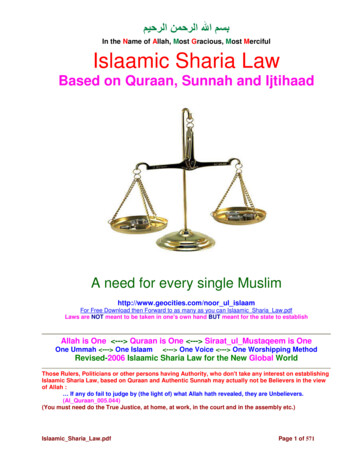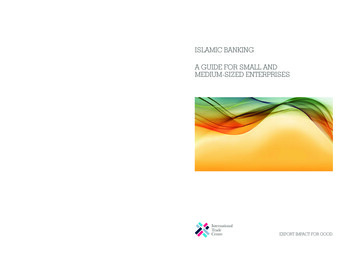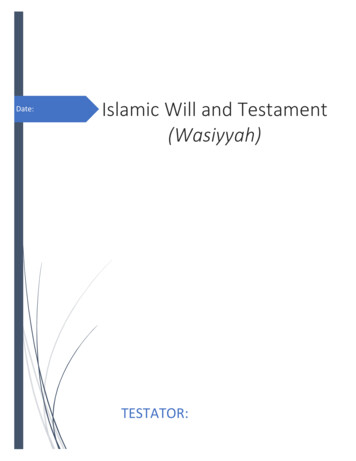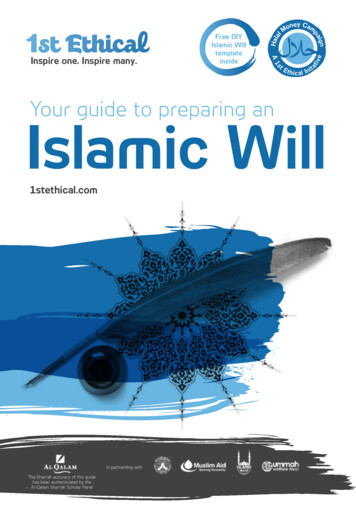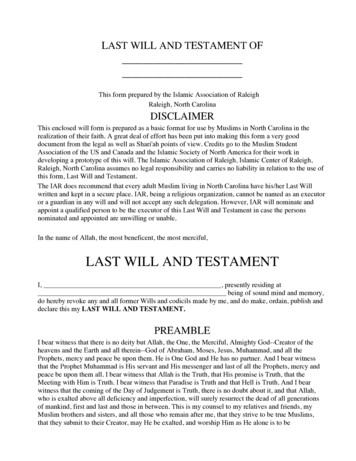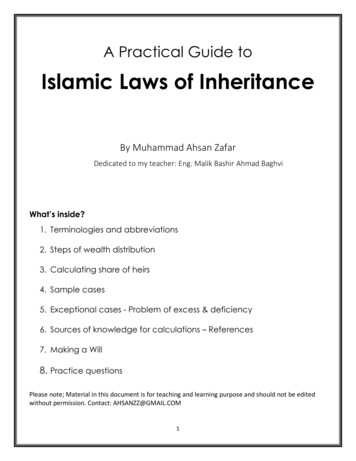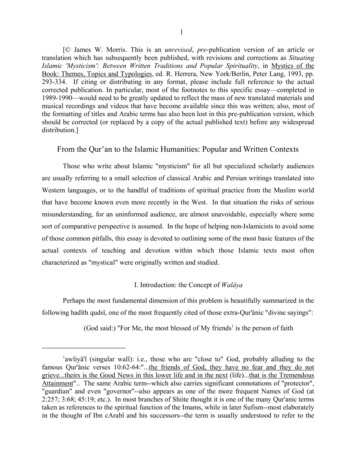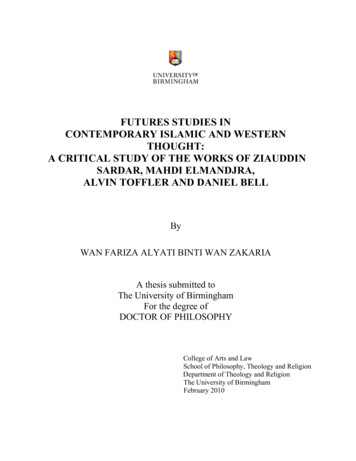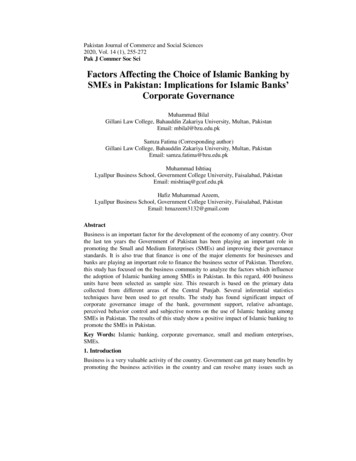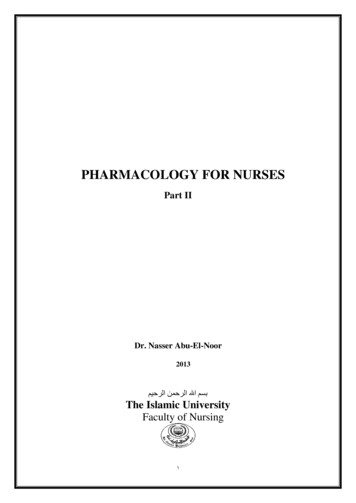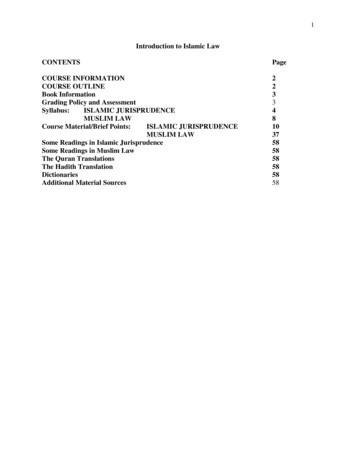
Transcription
1Introduction to Islamic LawCONTENTSPageCOURSE INFORMATIONCOURSE OUTLINEBook InformationGrading Policy and AssessmentSyllabus:ISLAMIC JURISPRUDENCEMUSLIM LAWCourse Material/Brief Points:ISLAMIC JURISPRUDENCEMUSLIM LAWSome Readings in Islamic JurisprudenceSome Readings in Muslim LawThe Quran TranslationsThe Hadith TranslationDictionariesAdditional Material Sources2233481037585858585858
2COURSE INFORMATIONCOURSE NAME/SEMESTER:Section #CourseCourse Area:Spring 2015226575397 Introduction to Islamic LawInternational LawPROFESSOR:Contact:Credits:SHAHZADO SHAIKH 0p-9:00p MWRoom:Exam:05/09/15 9am-12pmPrerequisites/Skills/Course Requirement: No prior course work is required.First Day Assignments: NoSenior Upper Level Writing Requirement: NoStudents may meet: 6:30p-7:30p MWStudents can also contact to set up appointment.Location: UH LCCourse Outline:Based on a belief system of a divine origin, Shariah envisages, both, a religion and asocial order. The course seeks to introduce core textual (as the basic source), theological(belief system), and legal components, along with historical impact, while examiningdifferent phases, through its sources and methodologies, leading to development ofschools of opinions and legal theories.The course will examine texts, history and current issues in Islamic Law and itsenforcement.It will also study principles, concepts and terminology of Islamic Jurisprudence andMuslim Law,It will introduce some aspects of Islamic law pertaining to substantive areas, likeconstitutional, commercial, international, and criminal laws; and some specific areas likemarriage, divorce, child custody; succession and wills. These areas will be examined withreference to the law of the land and some cases discussed in US courts in the context ofIslamic Law.
3Some important issues, will also come under debate, including, Human Rights,Terrorism, Political Islam, Women’s Rights, Rights of religious minorities, Punishments,and Finance preferences (e.g., Islamic Banking, Trade and Finance).Growing fundamentalism in approaches to Islamic Law and its relevance in today’sworld, is bound to be contested. Islamic law and its relation to modern historical andpolitical developments will be discussed, including divergent conceptions of violence andpolitical interest and authority.Book Information:The list is given at the end.Books may not necessarily be purchased for this course.Digital copies of the suggested and supplemental Books have been provided. Studentscan photocopy/e-copy them.In addition, topic-wise Brief Points and Course Short Notes have also been provided,which can also be copied/downloaded.Furthermore, lectures will be supported by Power Point Presentations/Slides.Grading: UH LC PolicyAssessment:1. Attendance, Class Participation, & Presentations (5-10 minutes): 10%,2. Knowledge of topics, texts, and writings:Examination:70%Engagement with the subject will be in a format:-Intro, Brief and General Summary, along with overarching assessment.-Citation,-Conclusion.Course materials and Books can be used during examination.Personal Computers can be used in classroom and during examination.Assignment/Project/Case Study:i.ii.iii.20%1-2 page memo on some selected Project,Selected rule of Muslim Law of any Muslim country to write a 12-page analysis or review,andCase Study.Style: Options:i. Persuasive (argue a thesis, attempt to prove a point),ii. Comparative (compare more than one perspectives)iii. Interpretive,iv. Explanatory.
4Syllabus:ISLAMIC JURISPRUDENCE1. Short Introductions:1.i. Pre-Islamic Arabia-social and economic conditions,-beliefs and customs,-Istis-hab (Presumption of Continuity),-Stare Decisis.-- influence on Islamic law1.ii. Five Pillars of Islam1.iii. The Articles of Faith1.iv. The Moral Basis of Islamic Law-Enjoin Good and Prohibit Wrong1.v. The Grundnorm of Islamic Law1.vi. Islam1.vii. Political Islam1.viii. Politico-Notional Differences2. Islamic Law as a Divine Law and its Sources.Sources of Islamic Law2.i The Quran,2.i.a. The Basic Source of Law,2.i.b. Approaches to understanding the texts: Selected Verses,2.i.c. Concept of Naskh (abrogation, amendment)2.ii The Revelation and the Reason:2.ii.a. Divine Law: based on Revelation:2.ii.b. Man-made Law: based on Reason2.iii. Mutazilah3. The Sunnah3.i. The Primary SourceIts relationship to the Quran
53.ii. Approaches to understanding3.ii.a. the texts: Selected Traditions3.ii.b. Athar (Impact) and Amal (Practice)3.ii.c. Practice and Transmission3.iii. Sunnah and Hadith3.iv. Hadith3.v. Difficulties In Acceptance Of Hadith4. Qiyas (Analogy)5.Ijma (Consensus)5.i. Ijma (Consensus)5.ii. Qiyas-Ijma-Qiyas .6. Historical Development of Islamic Law:6.i. Early development of Islamic Law6.ii. Legal schools: opinions and methodology6.iii.Hanafi Interpretation or Methodology6.iv. Maliki Interpretation or Methodology6.v. Shafai Interpretation or Methodology6.vi. Hanbali Interpretation or Methodology6.vii. Perspective to Shia Law6.viii. Kulayni6.ix. Important factors in development of fiqh6.x.Authority according to Sunni and Shia6.xi. Umayyads (661-750 CE)6.xii. Abbasids (750-800 CE)6.xiii. Development of Judge-made Lawand Administration6.xiv. Some Reasons of Disagreement6. xv. Schools of Islamic Law and Sects6.xvi. Spatial Development6.xvii. Application of Raay-i and availability of Hadith6.xviii. Academic Impetus6.xix. Ottoman World and Turkey6.xx. From Ottoman to Muslim World:-Shariah in secular Muslim states,-Muslim states and some other states with blended sources of law,-Muslim states applying Shariah6.xxi. Learning From Lessons6.xxii. Research and Reform6.xxiii. Some Serious Issues Involved:
67. Short Introduction to the Terminology7. Fiqh8.Usul ul Fiqh8.i. Usul ul Fiqh8.ii. Khilaf9. Important Terminology9.i. Ijtihad9.ii. Istihsan (Juristic Equity)9.iii. Istidlal9.iv. Istislah9.v. Takbayyur(selective choice from alternate opinions)9.vi. Ellah9.vii. Fatwa9.viii. Mujtahid, Mufti, Faqih, Mufti, Muqallid9.ix. Taqlid10. Concepts and Practices of Islamic Law10.i. Deen10.i.a. Purposes of Deen10.i.b. Principles (Maxims) of Deen10.ii. Mazhab10.iii. Millah10.iv. Shariah10.v. Minhaj10.vi. Nusk10.vii. Shariah Law10.viii. Shariah and Law10.ix. Shariah Based Law10.x. Muhammadan Law10. xi. Muslim Personal Law10.xii. Muslim Law
711. Legal System of Islam11.i. Legal Institutions and Practices:11.i.a. Qadi11.i.b. Court System11.i.c. Procedure11.i.d. Shahadah (Evidence)11.i.e. Hearing11.i.f. Decree11.i.g. Agency (Wakalah)11.i.h. Justice11.i.j. Jurisdiction11.i.k. Punishments:-Hadd (standard):--Concept of Deterrence-Tazir (discretionary)11.ii. Muamilat (Civil Matters):11.ii.a. Ownership (‘Milk’)11.ii.b. Possession11.ii.c. Contract11.ii.d. Claim (da'wa)11.iii. System of Rights and Obligations:-Rights-Obligations11.iv. Acts (mahkoom fih)11.v. Person (mahkoom alayh)11.v.a. Legal Capacity (ahliyah),11. v.b. Fictitious Person11.vi. Hukm:-Primary Rules (Hukm Taklifi)-Secondary Rules (Hukm Wad’i)
8Syllabus:MUSLIM LAW1. Contemporary Development of Muslim Law2. Muslim Personal aintenance.7.Child .Paternity: Legitimacy & Acknowledgement13.Guardianship of Person and Property14.Gift15.Wakf16.Marzul- Maut17.Pre-emption18.Administration of Estate of deceased19.InheritanceInheritance-General RulesHanfi & Shia Law of InheritanceStudy of Selected Sections of the Enactments in Some Muslim Countries,such as:The Dissolution of Muslim Marriages,The Muslim Family Laws,Muslim Personal Law (Shariat) Application Acts,The Guardian and Wards Act,The Child Marriage Restraint Act,Marriage and Divorce (Registration) Act,Dowry Prohibition Act,Family Court Laws.3. Muslim Family Laws (Enactments)3.i. Marriage:3.ii. Dower (Mahr)3.iii. Dissolution of Marriage,3.iv. Repudiation (Talaq) by husband:3.v. Dissolution of marriage by wife:
94. Human Rights:-Rights of God (Huqooqallah):Individual and Public Rights for greater good-Rights of human beings (Huqooqal-ibaad)5. Broader Principles of Human Rights and Fundamental Rights6. Universalization:Da'wah (invitation)Inter-FaithRights of Religious MinoritiesRights of non-Muslims7. Women’s Rights and Status:8. Terrorism9. Jihad10 Torts and CrimesTa‘zir (chastisement)Hadd: (measure, limit)Hudood (plural): Hudoodallah:Qisas: punishment by similar hurtDiyat: specified compensation payable to heirs of victim11. Doctrine and Process of Siyasah12. Constitutional and Administrative Laws13 Commercial Laws13.i. Principles of Economic System13.ii. Riba (unlawful advantage by way of excess or deferment);13.iii. Islamic Banking13.iv. Features of Islamic Trading13.v. Principles of Financial Dealings and Distribution Of Wealth14. International Law:-Islamic law of nations; treaties, concept of just war:-Relations between Muslims and Non-Muslims15. IslamizationGradual Unfolding of Legal System of Islam-Case of Liquor
10Course Material/Brief Points:ISLAMIC JURISPRUDENCE1.Short Introductions:1.i. Pre-Islamic Arabia-social and economic conditions,-beliefs and customs,- Istis-hab- Stare Decisis--its influence on Islamic law:Arab society was tribal.Customary law of property, contract, inheritance, and obligations.Elementary forms of land tenure.Elementary legal system mostly through arbiters (hakam).Islam reformed some pre-Islamic customs and adapted them to internal consistency ofthe Quranic and the Prophetic sanction.Stare Decisis (Latin): Let the decision stand, abide or adhere to decided cases, the policyof courts to adhere to principles established in earlier cases.Istis-hab (PRESUMPTION OF CONTINUITY)General principles:1.ii. Five Pillars of Islam:(i) Declaration of Faith (Shahadah: testify):“There is no god save Allah, Muhammad is the Messenger of Allah".(ii) Prayer (Salat): inculcate and sustain ad-deen as a system,(iii) Poor Welfare Tax (Zakat: system for enhancing and extending economicwelfare, at the base level)(iv) Fasting (Sawm): (exercise for fitness andphysical capacity).(v) Pilgrimage (Hajj): Hajj (summit for universalization and integration throughwider dialogue and interaction.1.iii. The Articles of Faith:Allah, the only one Lord,Angels,Books,Prophets,
11Resurrection, and the Day of Judgment;Al-Qadar (deterministic regulation, e.g., cause and effect)1.iv. The Moral Basis of Islamic Law:Enjoin Good and Prohibit Wrong: (7:157)1.v. The Grundnorm of Islamic Law:The Grundnorm is the doctrine that the legal sovereignty over the entire universe belongsto Almighty Allah alone, and the authority is exercisable by people within the limits prescribedby Him, as a sacred trust.1.vi. IslamThe term Islam means total submission to the Will of Allah. Incomplete or partial surrenders' or submissions' creates a patch work of contradictions and conflicts, because thenumbers of non-compliances', in that case, could be any.1.vii. Political IslamConfusion exists for not differentiating the following:Ummah is sans bordersMuslim state has geo-political dimensions,Muslim Community has a locus.Muslim community has internal goals that form its subsystems:-protection of Deen,-preservation and protection of life,-maintenance of family unit and its values,-development of personality and intellect,-economic well-being,Though Khilafat had practically ceased to have any significance, jurists, beforeIbn Taymiyah, still clung to its concept, and even after it was demolished byMongols.Ibn Taymiyah did not "presuppose the existence of a state" and denied that a stateas implied in the concept of khilafah had ever been established by the Prophet. Hesaid that the period of the Prophet was nubuwwah; he wielded authority, primarily asProphet and not as head of state. Supremacy of Shariah could be the principle inkhilafat or mulk (state). Imamate (spiritual authority) on the basis of descendencecould also never afford a long term alternate. He also rejected concept of rule ofclergy. Ibn Taymiah denied concept of khalifat Allah, with divine rights, aboveShariah. Idea of universal caliphate was a fiction. He advocated legality ofmultiplicity of states.Supremacy of Shariah means implementation of purposes of Shariah, implyingthat form of government does not affect it. Shariah supremacy can itself ensure thatjustice is maintained and rights of each individual and group are secured through dueprocess of law.‘Democratic’ principles are upheld by Islamic law as means of good governance.
121.viii. Politico-Notional Differences:Imamate and Caliphate form the basis of two major approaches or schools, that are politiconotional in nature.Khalifa (caliph) is idealized in Shariah compliance and in his character.In concept of Imam (leader), temporal affairs occupy secondary position. Imam is idealized inhis infallibility as final interpreter of law.Concepts of Imamate and Caliphate, basically political in nature, have been sealed in faith; notallowed to be open to notions of sovereign modern-state craft.2.Islamic law as a Divine Law and its sources.Sources of Islamic Law2.i The Quran,2.i.a. The Basic Source of Law,2.i.b. Approaches to understanding the texts: Selected Verses,Approach hah and Lisan,Approach 2:Culture,Biblical basis,Time-line,Approach 3:Word,Verse,Ruku (group of verses),Surah (Chapter)Test and Total Context.Approach 4:Quran in the light of”-its own Text (Quranic Nass),-Sunnah Text (Sunnah Nass),-Bible,-History,-Sciences,Approach 5:Interpreters individual approaches from the Companions to-date.
132.i.c. Concept of Naskh (abrogation, amendment)2.i. The Quran2.i.a. The Basic Source of Law,The Quran is unanimously accepted as the fundamental source of law from whichpositive law, and primary and secondary rules can be deduced. An ordainment in the text(nass) of the Quran is accepted as the law (sharaee hukm), where evidently manifest.The Quran regulates relationship of man with man as extension of his relationshipwith God. Huqooq-ul ibaad (human rights) are protected by huqooq-ul-Allah (rights ofAllah) and His parameters (hudood-Allah). The Quranic legislation is not drafted inpurely legal terms. It is, inter alia, amalgam of law and ethics, occasionally instilling Hisfear, for careful compliance.The Quran is not ‘pan-legistic’, i.e. does not lay down all details once and for all. The Quranprincipally sets norms for law, and rules by which Islamic system of justice is to be structured.The legislative content of the Quran provides basis for detailed legislation and legal formulationand does not constitute a legal code by itself.The injunctions were not revealed in vacuum, but as practical guide to the Prophet,leading through the medium of human society. The Quran does not give minutiae, butindicates basic principles that lead to find answer by one’s own effort. It presentsideology in general terms, as steering force, in changing circumstances. It highlightsboundaries of various aspects of life, in which the Prophet presented the practical model,primarily exemplifying the teachings of the Quran, so that it is not simply a compendiumof ethics.2.i.c. Concept of Naskh(abrogation, amendment, annulment)Naskh: In classical Fiqh, it has different connotations:-the Quran abrogated the laws enunciated in earlier Divine Scriptures,-abrogation of some of earlier commandments of the Quran by the later,while texts of those earlier commandments remain embodied,-clarification of some earlier commandments of the Quran by the later,while texts of those earlier commandments also remain,-Explanatory verses were considered as nasikh. It did not mean that latterabrogated the former,-Some pronouncements are general while others explain their meaning;the Quran explains itself.Classical theory of naskh does not trace back to the Prophet. If any passages wereabrogated, he would have definitely informed. Concept of abrogation was not there in thelifetime of the Prophet. Almost every passage held abrogated, is disputed. Differences ofCompanions imply that there was no instruction from the Prophet, in this regard. Itemerged later for reasons of legal exigency or consistency.2.ii The Revelation and the Reason:2.ii.a. Divine law: based on Revelation:
14In a Divine system the superiority is claimed for the Divine Lawsand that these are immutable.2.ii.b. Man-made law: Based on ReasonThe Quran stated general principles which were developed, construed, interpreted andapplied by the Prophet (Peace be upon him). The Quran prescribes to refer back to the source(the Quran and the Sunnah) in case of differences or discord. It exhorts not to follow it blindly. Aperson is not a true believer unless he understands his religion and is convinced by it.Process of revelation was validated as the true source, in precept and practice of theprophets, in a living society. The Prophet was not to preach his own desires: 53:2 to 4In Fiqh, Reason is not a separate source of law. In the Quranic context, the Fiqhrequires application of knowledge in a well coordinated and utmost exertion of humanfaculties; the process known as Ijtihad, leading to continuous process of Qiyas-IjmaQiyas-Ijma 2.iii. MutazilahAccording to Mutazilah, human intellect can guide man to know God, His attributes, andthe very basics of morality. They believed that the injunctions of God are accessible to rationalinquiry, and that knowledge, which distinguishes right from wrong, can be derived from reason.They believed in synthesis between reason and revelation. Both reason and revelation can cometogether as source of guidance and knowledge.Mutazilah believed that source of all laws is Allah. They also maintained thatreason can discover laws of Allah, even in absence of revelation.3. The Sunnah3.i. The Primary SourceIts relationship to the Quran3.ii. Approaches to understanding3.ii.a. the texts: Selected Traditions3.ii.b. Athar and Amal3.ii.c. Practice and Transmission3.iii. Sunnah and Hadith3.iv. Hadith3.v. Difficulties In Acceptance Of Hadith3.i. The Primary SourceIts relationship to the QuranThe Sunnah refers to normative practice set up by the Prophet as a model, underinstruction from God. The Quran enjoins to follow the conduct of the Prophet, as 'ideal'.Sunnah, as institution of Islamic Jurisprudence, with the progress of revelation,underwent evolution. The Sunnah developed in response to actual situations.3.ii.b. Athar (Impression, Impact) and Amal (Practice)Athar (impression) and Amal (practice) of Companions, elaborate the Sunnah, asnext (add-on) source. Companions were immediate observers and followers of the
15Sunnah, acquainted not only with Prophet’s word, conduct, and wisdom in silence, butalso their spirit and ideal.3.ii.c. Practice and TransmissionContinuity of the established practice was proof by itself. Companions settled indifferent regions. They were interpreters and elaborators of the Sunnah of the Prophet.Practical aspect of Companions’ life had far-reaching effect on conduct ofSuccessors. People accepted their Ijtihad as authoritative, which ultimately tended tobecome Ijma of the Community. However, sunnah of the Companions (Sunnat alSahabah), in many cases was based on personal opinions, giving rise to controversiesamong jurists of second century Hijrah.3.iii. Sunnah and HadithHadith is narration of precept and practice of the Prophet. Sunnah presents the lawdeduced from this narration. Hadith is carrier of the Sunnah. Sunnah is found in wellknown traditions, established practice and agreed usages. One Hadith may contain morethan one Sunnahs. The term sunnah was also used for established practice of Muslimscoming down from the time of the Prophet.3.iv. HadithInitially narration of the behavior of the Prophet by the Companions was knownas Hadith, conforming to the established practice continued since time of the Prophet.Hadith is index and vehicle of the Sunnah.Free narration of Hadith resulted in fabrication also. Differences arose as a result ofconflicting Hadith in circulation. Shia relied on their narrators of Hadith (ahl-ebayt:members of the house) and differed from Ahl al-Sunnah.Established practice of Medina was considered to be the channel to judge the realSunnah.3.v. Difficulties In Acceptance Of HadithSometimes a Hadith was available but the reporter himself could not understand itsreal import.Flexibility and leeway provided by different descriptions, decisions andinterpretations of Hadith, depending upon reporting of different aspects of situationsvariously, and scope and prospects of interpretations of the Quran, with unfoldinginformation provided a spectrum of opinions.If some Hadith did not conform to a verse in the Quran, it gave rise to differentopinions among Companions. If reporting contained contradiction, Companions andSuccessors followed it differently.4. Qiyas (Analogy)Qiyas is a method of discovering a law laid down in the Quran and the Sunnah. Law on apoint not expressly dealt with by the texts or by the concurrent decision of the learned isregarded as uncertain. Laws based on analogy, have to be proved from these two primarysources.
16Qiyas is to find out essential common factor (ellah) between two similarcases, to apply the rule of one to the other, i.e., comparison between two parallelsbecause of their resemblance, technically known as ellah (shariah value).5.Ijma (Consensus)5.i. Ijma (Consensus)5.ii. Qiyas-Ijma-Qiyas .5.i. Ijma (Consensus)Ijma ensures veracity of new legal content emerging from Qiyas and Ijtihad, ascheck against its fallibility. Universal agreement of entire Community (Ijma ofCommunity) is generally confined to obligatory duties (faraid).Generally Ijma represents average general opinion of a region, setting aside strayopinions.5.ii. Qiyas-Ijma-Qiyas . A Continuous ProcessEarly schools placed Qiyas before Ijma. Conflicts over reducing importance byway of preference of one over the other, undermined the cause of ijtihad, process ofQiyas and achievement of Ijma (consensus). Then there were severing debates onkinds of consensus and Qiyas. In fact, Qiyas and Ijma, both are complementary andsupportive of each other in continuous process.Those who subscribe to the view that Qiyas precedes Ijma, argue that perpetualhuman dynamics continuously evolve new situations which can be responded withdifferent options through Qiyas based on Ijtihad.6. Historical Development of Islamic Law:6.i. Early development of Islamic Law:6.ii. Legal schools: opinions and methods:6.ii.a. Kufah: Abu Hanifah and his students6.iii.Hanafi Interpretation or Methodology6.iv. Maliki Interpretation or Methodology6.v. Shafai Interpretation or Methodology6.vi. Hanbali Interpretation or Methodology6.vii. Perspective to Shia Law6.viii. Kulayni6.ix. Important factors in development of fiqh6.x.Authority according to Sunni and Shia6.xi. Umayyads (661-750 CE)6.xii. Abbasids (750-800 CE)6.xiii. Development of Judge-made Law
17and Administration6.xiv. Some Reasons of Disagreement:6. xv. Schools of Islamic Law and Sects6.xvi. Spatial Development6.xvii. Application of Raay-i and availability of Hadith6.xviii.Academic Impetus6.xix. Ottoman World and Turkey,6.xx. From Ottoman to Muslim World-Shariah in secular Muslim states:-Muslim states and some other stateswith blended sources of law:-Muslim states applying Shariah:6.xxi. Learning From Lessons:6.xxii. Research and Reform6.xxiii. Some of Serious Issues Involved:6.i. Early development of Islamic Law:Growth and Compilation:Written manuals of fiqh go back to second century Hijrah.By early schools of law is meant traditions prevalent in different regions beforeShafai, against whom he argues.Subsequent sources present medieval picture.Malik composed first systematic work (Muwatta) on Fiqh,Shafai systematized,Juwayni (al-ashbah wa al-naza'ir) laid down general principles,Qarafi is credited for al-furuq (art of distinguishing cases), andGhazali (d. 505 A.H.) for reconciling principles of various schools, andnew theory of purposes of law (jurisprudential interests).The Prophet laid down regulations, and jurists, later, elaborated them in detail.The Prophet himself had made allowances in his commands, and left a lot to theCommunity to decide according to emerging situations.During the time of the Successors, in geographical divisions, independent legalactivity was going on. The regional schools were engaged in intense legal activity,which in modern terms may be called ‘legal activism’, which generates controversyalso. Local elements were very powerful.6.ii. Legal schools: opinions and methods:Opinions in Islamic law, grouped together systematically, are known as school of law.Schools of Islamic law differ due to systems of interpretation, influenced bymethodology.There was no concept of organized political parties. Opposition groups gathered aroundjurists. Separation between theory and practice or separation between theory of jurists andpractice of Muslim rulers (state) starting immediately after first four caliphs, continued
18throughout centuries, so that the gap increasingly became wider and deeper. Schacht perceiveduntidy relationship between ideal theory of Islamic law and actual practice by Muslims.Therefore, common unified legal system and one corpus of law did not develop ininstitutionalized consultative frame of a society or state.6.iii.Hanafi Interpretation or Methodology:Hanafi legal theory revolves around use of general principles:Proof by the Quran and by the Sunnah, Ijma and the Opinion of a Companion.Abu Hanifah accepted qiyas (analogy) and acted upon it, but with narrower scope.6.iv. Maliki Interpretation or MethodologyMalik accepted istihsan and opinion of Companion. Malik’s modes of ijtihad had followingfeatures:1. Practice of the people of Madinah preferred over qiyas,2. Maslahah Mursalah, i.e. interest that has neither been expressly confirmed by theLawgiver nor has it been rejected.3. Opinions of Companions as valid proof for purposes of ahkam, should be preferredover qiyas, when there is no tradition from the Prophet in the case.4. If an individual narration is contradicting the practice then it is not a legally valid proof(hujjah).5. Malik upheld istihsan.6.v. Shafai Interpretation or MethodologyShafai’s method of interpretation was against use of general principles, in order to stay asclose to revelation as possible. However, he accepted the four sources of law, in the order: theQuran, the Sunnah, ijma and qiyas.Shafai was the first jurist to write about rules of literal construction and then raise fiqh onthem. He laid down conditions for the acceptance of the traditions. He opposed principle ofistihsan. He accepts principle of ijma but not exactly in form laid down by classical definition.He does not mention maslahah mursalah in his principles.6.vi. Hanbali Interpretation or MethodologyHanbali school accepted mursal traditions, preferred them over general principles and onanalogy constructed on them. Ibn Qayyim states that these principles are:1. The Texts (Nusus): The Quran and those traditions whose chains are complete,2. Opinions of Companions:(i)Opinion of Companion not opposed by other Companions, is accepted,(ii)If opinions are more than one, the closest is to be accepted.3. Qiyas is source of law of last resort.6.vii. Perspective to Shia LawShia (Shiatu Ali: followers or faction of Ali), believed Ali as Muhammad's successor asCaliph. Sunnis held that political leader was to be from Quraysh (tribe of Muhammad).Followers of the Imams assert that at any given time, whether in power or not, a maledescendant of Ali and Fatimah was the divinely appointed imam and sole authority in matters offaith and law. Imam is considered infallible, free from error and sin, who rules over community
19with justice and is able to interpret the divine law. Some give importance to the Imam of theAge, who defines jurisprudence, and his guidance may differ from previous Imams because ofdifferent times and circumstances.6.viii. KulayniKulayni (d. 329/941) was the foremost compiler of Hadith following Ahl al-Bayt, andMujaddid (reviver) of 3rd century.Among Kulayni’s books, Kitab al-Kafi (source book of ahadith), is considered importanton responsibilities of human beings prescribed by Shariah. He presents a rationalist approachthat God does not burden man with impossible duties.6.ix. Important factors in development of fiqh(a) Quran maintained continuity of the Revealed Scripture,(b) practical modeling (the Sunnah),(c) prevalent practice (sunnah and ijma),(d) sustainability through justice, equity and morality, within over allframe of monotheism, social reference in time and place.Monotonic unity of ummah in specific terms, and unity of mankind in general, isnot possible through one-piece jurisprudence (fiqh or even Shariah). Not only because ofvariations of features in geographical span, but also because of cultural and racial mix,there could not be one-piece legislation for all variety of human behaviors in differentlocal settings.6.x.Authority according to Sunni and ShiaDispute over Imamate or Caliphate, continues to divide Muslims. Dissident party(Shia) asserted that Imamate should have continued in the family of Prophet, although Alihimself did ot openly put forward such claim. The other party (jama-at) ‘elected’ AbuBakr.Ulil-amr (those in command) have to be qualified and able to interpret law, i.e.,one of necessary qualifications for imam (leader) is to be mujtahid.6.xi. Umayyads (661-750 CE)During Umayyad period (41 A.H. till beginning of second century Hijrah), public law, e.g.,laws pertaining to fiscal matters, regulation of non-Muslim subjects, in the scenario of expandingterritories, etc., developed.Qadi gave effect to legal directives issued by central authority or local governors. Matters ofprivate law, were left largely to individual qadis, who, consequently, made their contribution todevelopment of law, in this sphere. Qadis made effort to adapt customary law
Growing fundamentalism in approaches to Islamic Law and its relevance in today’s world, is bound to be contested. Islamic law and its relation to modern historical and political developments will be discussed, including divergent conceptions of violence and political interest and authority.
